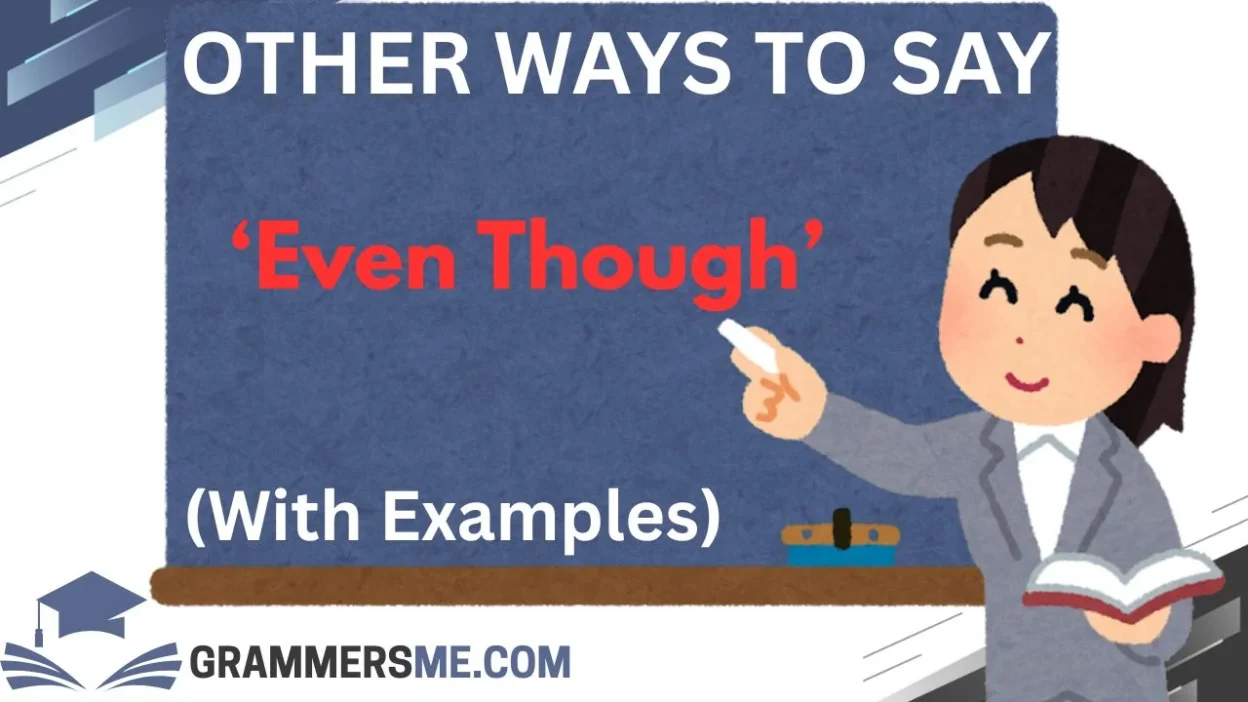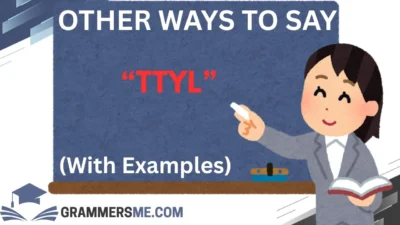Finding the right words can be a powerful way to show empathy, soften difficult truths, or add warmth to conversations—especially when navigating contrast, contradiction, or vulnerability. “Even though” is often used to introduce complexity in a situation, but sometimes it can sound too abrupt or overused. Whether you’re writing a heartfelt note, having a thoughtful discussion, or composing a professional message, having gentler or more expressive alternatives can make a world of difference.
As someone who’s spent years helping people shape their words with more care, I’ve found that language truly has the power to connect or distance—it’s all about how we choose to frame our thoughts. This list is designed to help you make more intentional and thoughtful choices in how you express contrast.
What Does “Even Though” Mean?
Meaning: “Even though” is a subordinating conjunction used to introduce a contrasting or surprising idea. It implies that one thing is true or happens despite another.
Example: “Even though it was raining, she went for a walk.”
Tone: It can feel neutral or slightly blunt, depending on the context.
Is It Professional/Polite to Say “Even Though”?
Yes—but context matters. While “even though” is grammatically correct and widely accepted in both casual and professional settings, it can sometimes feel direct or lacking warmth. In more thoughtful or emotionally nuanced communication—especially in writing—it’s often more impactful to choose softer, more compassionate alternatives.
1. Although
Meaning: Used to introduce a contrast or concession.
Explanation: A formal, yet gentle synonym for “even though.”
Example: “Although he was tired, he stayed up to finish the project.”
Best Use: Emails, essays, or thoughtful conversations.
Not Use: When you want to sound more casual or conversational.
2. Though
Meaning: A more casual alternative to “although.”
Explanation: “Though” is versatile and can be placed at the beginning or end of a sentence.
Example: “He came to the party, though he didn’t feel like it.”
Best Use: Everyday conversations, informal writing.
Not Use: Extremely formal settings or business documents.
3. While
Meaning: Shows contrast between two ideas happening at the same time.
Explanation: Often used for balance between two truths.
Example: “While I don’t agree, I understand your point.”
Best Use: Discussions where balance and respect are key.
Not Use: If it may cause confusion with the “time” meaning of “while.”
4. Whereas
Meaning: Indicates a clear contrast between two ideas.
Explanation: More formal and structured, often used in comparisons.
Example: “She prefers tea, whereas he loves coffee.”
Best Use: Formal writing, professional reports.
Not Use: Casual or emotional conversations.
5. Even If
Meaning: Focuses on possibility rather than fact.
Explanation: Adds a hypothetical or emotionally complex tone.
Example: “Even if I fail, I’ll be proud of myself for trying.”
Best Use: Encouraging messages or introspective writing.
Not Use: When the situation has already happened.
6. Despite the Fact That
Meaning: Shows contradiction in a more formal tone.
Explanation: Adds weight and seriousness to your point.
Example: “Despite the fact that it was risky, she took the leap.”
Best Use: Professional emails or formal essays.
Not Use: In light, breezy conversations.
7. In Spite Of
Meaning: Similar to “despite,” but slightly softer.
Explanation: Can make your tone feel more intentional.
Example: “In spite of the challenges, he kept going.”
Best Use: Thoughtful writing, motivational tone.
Not Use: Informal texting or everyday chit-chat.
8. Nonetheless
Meaning: Introduces a surprising continuation or conclusion.
Explanation: More commonly used at the beginning of a sentence.
Example: “She was afraid. Nonetheless, she stood up.”
Best Use: Motivational writing, persuasive speech.
Not Use: Conversations that need simplicity.
9. Still
Meaning: Highlights continuation despite circumstances.
Explanation: Feels conversational and gentle.
Example: “He didn’t win. Still, he was proud.”
Best Use: Personal messages, storytelling.
Not Use: Formal reports or professional presentations.
10. Yet
Meaning: A concise way to introduce contrast.
Explanation: Works best in shorter, punchier sentences.
Example: “She was sad, yet hopeful.”
Best Use: Creative writing, poetry.
Not Use: Long, complex sentences that require more clarity.
11. However
Meaning: Contrasts two complete sentences or ideas.
Explanation: Polished and professional but still warm when used well.
Example: “He was qualified. However, he didn’t get the job.”
Best Use: Emails, reports, thoughtful writing.
Not Use: Overuse can make writing feel robotic.
12. But Still
Meaning: Adds a human, emotional touch to contradiction.
Explanation: Softer than “but” alone.
Example: “She apologized. But still, it hurt.”
Best Use: Empathetic or emotional writing.
Not Use: Very formal settings.
13. Even So
Meaning: Surprising outcome despite known facts.
Explanation: Similar to “nonetheless” with more warmth.
Example: “It was late. Even so, she waited for him.”
Best Use: Personal stories, encouraging feedback.
Not Use: Technical writing.
14. Granted That
Meaning: Acknowledges something is true before introducing contrast.
Explanation: Helps show thoughtfulness and openness.
Example: “Granted that it’s risky, we still believe in the idea.”
Best Use: Balanced arguments or thoughtful essays.
Not Use: Super casual or fast-paced conversation.
15. Even After
Meaning: Shows persistence beyond a point in time.
Explanation: Focuses on resilience or continuity.
Example: “Even after the loss, he kept smiling.”
Best Use: Uplifting writing, reflective storytelling.
Not Use: In technical or policy documents.
16. All the Same
Meaning: Introduces a surprising or persistent truth despite prior facts.
Explanation: Carries a reflective tone, suggesting internal strength or emotional depth.
Example: “He made mistakes. All the same, she trusted him.”
Best Use: Reflective writing, emotionally layered storytelling.
Not Use: Technical or overly formal writing.
17. Regardless
Meaning: Indicates something continues despite a condition.
Explanation: Straightforward and strong; conveys determination.
Example: “Regardless of the weather, we’ll go hiking.”
Best Use: Confident or decisive messages.
Not Use: When gentleness or empathy is needed.
18. Be That As It May
Meaning: Acknowledges a point but moves the conversation forward.
Explanation: Slightly old-fashioned, but poetic and wise.
Example: “Be that as it may, I still believe in her.”
Best Use: Narrative storytelling, formal reflection.
Not Use: Everyday conversation—can sound too stiff.
19. Still and All
Meaning: A more emotional or poetic version of “still.”
Explanation: Often used in storytelling or reflective speech.
Example: “She was wrong. Still and all, I cared deeply.”
Best Use: Poetry, personal essays, emotional storytelling.
Not Use: Formal or corporate writing.
20. But Even So
Meaning: Adds surprise or emphasis to contrast.
Explanation: Blends “but” with “even so” to deepen the contrast.
Example: “He didn’t call. But even so, she forgave him.”
Best Use: Messages with emotional complexity.
Not Use: Simple or fast-paced conversations.
21. Though It May Seem
Meaning: Softens contradiction with thoughtfulness.
Explanation: Creates space for empathy and understanding.
Example: “Though it may seem unfair, it helped her grow.”
Best Use: Coaching, counseling, reflective feedback.
Not Use: Short, direct responses.
22. Much As
Meaning: Balances admiration or agreement with contrast.
Explanation: Acknowledges something while gently disagreeing.
Example: “Much as I admire him, I don’t agree with his decision.”
Best Use: Respectful disagreement, nuanced conversation.
Not Use: When clarity or simplicity is the priority.
23. But Nevertheless
Meaning: Emphasizes perseverance or surprising outcome.
Explanation: Stronger than “but still,” adds gravity.
Example: “He lacked experience. But nevertheless, he succeeded.”
Best Use: Persuasive writing, motivational speaking.
Not Use: Overused or in brief messages.
24. Even When
Meaning: Highlights persistence in contrast to timing.
Explanation: Focuses on actions continuing during a condition.
Example: “Even when she was exhausted, she smiled.”
Best Use: Emotional depth, character building in stories.
Not Use: Where formality or directness is needed.
25. Still Though
Meaning: Colloquial and softens contrast.
Explanation: Used more in speech, especially casual dialogue.
Example: “It was a rough day. Still though, we made it.”
Best Use: Informal chats, comforting messages.
Not Use: Formal writing.
26. And Yet
Meaning: Adds emotional or poetic weight to contrast.
Explanation: Beautiful in writing where duality is a theme.
Example: “He failed. And yet, he smiled with peace.”
Best Use: Literary or personal writing.
Not Use: Professional settings unless stylistic flair is appropriate.
27. Even After All That
Meaning: Adds emphasis to past experiences or struggle.
Explanation: Evokes a sense of resilience or emotional journey.
Example: “Even after all that, she stayed by his side.”
Best Use: Deep reflections, memoirs, storytelling.
Not Use: Brief or transactional writing.
28. Though I Know
Meaning: Acknowledge awareness before sharing a contrasting thought.
Explanation: Builds emotional intelligence into the sentence.
Example: “Though I know it hurts, it may be for the best.”
Best Use: Supportive conversations, compassionate writing.
Not Use: Business memos or technical content.
29. Albeit
Meaning: A formal way to introduce contrast in a single sentence.
Explanation: Used more in written than spoken form.
Example: “It was a small victory, albeit a meaningful one.”
Best Use: Academic or elegant writing.
Not Use: Speech or casual text.
30. Even With That
Meaning: Adds a human element to contradiction.
Explanation: Sounds honest and heartfelt.
Example: “Even with that knowledge, I chose to forgive.”
Best Use: Personal essays, letters, deep conversations.
Not Use: Where direct, fast communication is needed.
Conclusion: Words That Carry Weight
Language has a beautiful way of shaping how people feel—and contrast doesn’t have to mean coldness. By choosing softer, more thoughtful alternatives to “even though,” we not only sound more human—we also build bridges in moments where misunderstandings could easily form.
Having helped others reframe their messages in ways that feel more authentic, I’ve seen firsthand how the right words can help people feel seen, safe, and heard. Whether you’re sharing your truth, offering support, or trying to be tactful, these alternatives give you space to say what’s real—with heart.
FAQs
1. What is the difference between “even though” and “although”?
Both convey contrast, but “although” is often viewed as more formal and is commonly used in writing. “Even though” adds emphasis.
2. Can I use these alternatives in professional writing?
Yes! Alternatives like “although,” “whereas,” “however,” and “nonetheless” are great in professional settings. Just avoid overly casual ones like “still though.”
3. Is “even though” too negative to use in sensitive conversations?
Not necessarily, but softer phrases like “though I know” or “in spite of” may convey care more effectively.
4. What’s the most emotional way to replace “even though”?
Phrases like “and yet,” “even after all that,” and “still and all” often carry emotional depth and are perfect for writing with feeling.
5. How do I choose the best alternative for my situation?
Consider your tone, audience, and setting. Ask yourself—do I want to sound warm, formal, or direct? Then choose a phrase that fits that intention.




